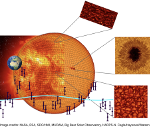|
|
|
|
Cool stars 21 Splinter session : Characterising stellar activity in the era of extreme radial velocity surveys of low-mass planets orbiting F-M stars Important message from the main conference organisation
The Cool Stars, Stellar Systems, and the Sun 21st Conference, originally planned to be held on June 22-26, 2020, in Toulouse, France, has to be postponed due to the current Covid-19 pandemic. The conference is now scheduled from the 4th to the 8th of July 2022, and our splinter session will be held on the 5th of July, from 2 to 6 pm.
Organisers
Nadège Meunier1, Xavier Delfosse1, Annelies Mortier2, Chris Watson3, Raphaëlle Haywood4, Heather Cegla5
1 Institut de Planétologie et d’Astrophysique de Grenoble, Université Grenoble Alpes, France 2 Kavli Institute & Cavendish Laboratory, University of Cambridge, UK 3 Astrophysics Research Centre, Queen’s University Belfast, UK 4 Astrophysics Group, University of Exeter, Exeter EX4 2QL, UK 5 Centre for Exoplanets and Habitability, University of Warwick, Coventry, CV4 7AL, UK2, Department of Physics, University of Warwick, Coventry, CV4 7AL, UK
Key information
1) Abstract submission for this splinter session is opened (see here for details). Deadline: 1st May 2022.
2) For details of the purpose of the session, and more information on our invited speakers, please read on! Our schedule can be found here. The list of relevant posters can be found here.
3) If you would like to express your interest in this session, or submit topics for discussion, you can use the same form as for abstract submission, even if you are not submitting an abstract. You can find the form here.
We look forward to hopefully seeing you in Toulouse!
Context A wide variety of complementary techniques have been used for a long time to characterise stellar variability, from both ground-based observatories and space missions. Examples of such techniques include studies of: chromospheric emission, X-ray emission, brightness variability (at various wavelengths), astrometry, Zeeman-Doppler imaging, and polarimetry. The interpretation of these observables is complex because they are disk-integrated and subject to several sources of degeneracy. Stellar variability, in turn, also manifests itself in radial-velocity (RV) measurements. On the one hand, this can be beneficial, and the field of asteroseismology exploited this principle long before the advent of space-based photometric missions such as CoRoT and Kepler. On the other hand, soon after the discovery of 51 Peg b it became clear that stellar variability can have significant consequences for the exoplanet field: stellar signals can hide the signals of true low-mass planets, mimic their existence, and affect the mass characterisation of the detected planets. While the number of exoplanets detected using RVs has dramatically increased over the last two decades (largely thanks to the stability of modern spectrographs), current measurements still face a limit on the obtainable RV precision of around 1 m/s. This limit is largely due to stellar variability, and it has been shown that RVs are sensitive to many processes occurring in the photospheres of stars arising from either magnetic activity, photospheric flows (occurring on various scales), or a combination of both. As a consequence, the interpretation of an RV time series is complex, but it also includes information on processes that are not observable using other techniques, which makes it very interesting for our understanding of stellar physics. Significant attention has, therefore, been devoted by a large community to the understanding of RV signals generated by stellar variability. This international, interdisciplinary effort has employed a variety of novel approaches (encompassing stellar and solar observations as well as simulations) to understand and model intrinsic stellar signals, with the ultimate goal of improving planet detection limits. These studies may prove critical to advance our understanding of low-mass planet formation, evolution, and ultimately life - and provides the focus for this splinter session. The organisation of this splinter session, which was proposed and accepted for the 2020 conference, remains timely for the following reasons:
Scientific motivation The issues outlined above are at the interface between stellar physics, solar physics and exoplanet science, and are of interest to a large community with various interests. In this splinter session, we wish to focus on the spectroscopic manifestation of stellar variability, but covering a large range of spectral types (F-M), where similar processes are present but with different relative impacts on radial velocities. We will also focus on attempting to significantly improve our understanding of RV variability to enable the detection of very low-mass planets. We have therefore two main objectives:
We will encourage attendees to develop collaborations across the various observational and theoretical techniques. There is much to be gained from further exploring those synergies and comparing the Sun to other stars.
Main conference website
For any matters relating the main conference, including registration and the code of conduct, we refer you to the main Cool Stars 21 website: https://coolstars21.github.io/ |


